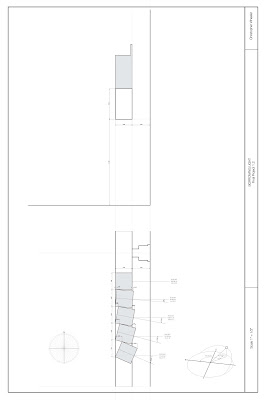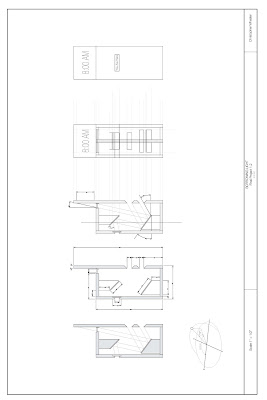

Borrowing Light is designed as a forum for discussion and creation. The aim is to understand how light - natural and artificial – can be used inventively in artistic and architectural production. The goal is to become familiar with light as a medium, begin to understand its inherent behaviors and material properties, and experiment with its (dis)appearance - to consider and represent its historical, philosophical, and cultural relevance.
 My site was a pathway located between two parking lots: the blue lot behind the Space Research Building, and the connecting orange lot. The path is rough concrete and it weaves through the woods. On a bright, sunny day, the light passes through the foliage in a specked pattern on the path- or in the winter, the sun casts long shadows from the bare branches. At night, a row of lamps arranged along the path lights the way. I chose this as a potential site because it’s an often used path, but removed from any sculptural works found in the more central and populated region of campus.
My site was a pathway located between two parking lots: the blue lot behind the Space Research Building, and the connecting orange lot. The path is rough concrete and it weaves through the woods. On a bright, sunny day, the light passes through the foliage in a specked pattern on the path- or in the winter, the sun casts long shadows from the bare branches. At night, a row of lamps arranged along the path lights the way. I chose this as a potential site because it’s an often used path, but removed from any sculptural works found in the more central and populated region of campus. There is already a specific light quality in the space, which I could choose to emphasize or draw attention to. I suspect the light is almost never appreciated, however, because the path is most often used by people arriving for work in the morning or leaving work at day’s end.
There is already a specific light quality in the space, which I could choose to emphasize or draw attention to. I suspect the light is almost never appreciated, however, because the path is most often used by people arriving for work in the morning or leaving work at day’s end. Placing a canopy above the path catches the shadows of the trees and branches, creating a “shadow screen” overhead. My hope was for the installation to draw attention to these shadows, which otherwise generally go unnoticed.
Placing a canopy above the path catches the shadows of the trees and branches, creating a “shadow screen” overhead. My hope was for the installation to draw attention to these shadows, which otherwise generally go unnoticed. In addition to creating a shadow-screen, I wanted to both convey and toy with the quality of light as it shines through and between leaves in a natural forest canopy. To achieve this, I laser cut a series of acrylic leaves, wove them into a thin net, and suspended them a few inches above the cloth. Light passing through these leaves created familiar and yet surreal shadows spaced among the natural branch shadows. Additionally, the canopy was supported by a branch-like metal structure sewed into the fabric, which then in turn was fastened to four surrounding tree trunks. In this way, the structure was a continuation of the trees reaching out over the path.
In addition to creating a shadow-screen, I wanted to both convey and toy with the quality of light as it shines through and between leaves in a natural forest canopy. To achieve this, I laser cut a series of acrylic leaves, wove them into a thin net, and suspended them a few inches above the cloth. Light passing through these leaves created familiar and yet surreal shadows spaced among the natural branch shadows. Additionally, the canopy was supported by a branch-like metal structure sewed into the fabric, which then in turn was fastened to four surrounding tree trunks. In this way, the structure was a continuation of the trees reaching out over the path.
 Below are stitched photographs showing the canopy-as-shadow-screen. Enjoy!
Below are stitched photographs showing the canopy-as-shadow-screen. Enjoy!


 This section of the windows is acting as a window. At night you see your own reflection in the window because it's light inside and dark outside. To reverse this, I added light outside so that the wall becomes the focal point of the window scene.
This section of the windows is acting as a window. At night you see your own reflection in the window because it's light inside and dark outside. To reverse this, I added light outside so that the wall becomes the focal point of the window scene. Outside, the window does the opposite, acting as a mirror and shielding the view of the interior. From this angle, the whole panel looks black.
Outside, the window does the opposite, acting as a mirror and shielding the view of the interior. From this angle, the whole panel looks black. If you get a bit closer to the window, you can make out what is going on both inside and outside--the bricks from outside sit on top of the interior image.
If you get a bit closer to the window, you can make out what is going on both inside and outside--the bricks from outside sit on top of the interior image. In this section of the installation I enhanced the reflective quality of the windows by adding more light. Normally the windows are already reflective indoors, but they are even more effective with the added lights.
In this section of the installation I enhanced the reflective quality of the windows by adding more light. Normally the windows are already reflective indoors, but they are even more effective with the added lights.1 Minute: LAX Night Window, Reflection, Sniff from michaeljohnmuller on Vimeo.
Video Document of 'within' (A Public Art Installation. Toronto Canada, 2009) from jol thomson on Vimeo.
Rear projected video on building.
TonhalleLATE from Projektil on Vimeo.
Amy Yoes' "Street-level" Night View from Art in General on Vimeo.